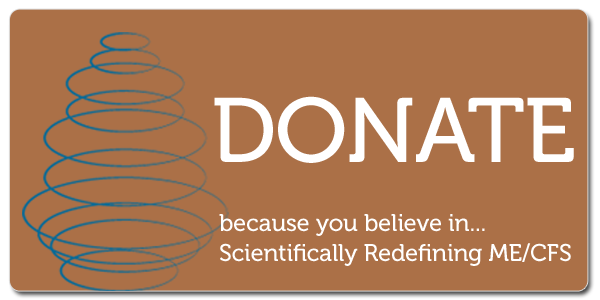Major Research Group Highlights Inflammation Energy Production Connection in ME/CFS
We propose that chronic low-grade inflammation induces and/or maintains persistent fatigue by inducing an imbalance between cellular-energy availability and cellular- and behavioral energy expenditure. Lacourt et al. 2018
Neurosci. 2018 Apr 26;12:78. doi: 10.3389/fnbeh.2018.00078. eCollection 2018. The High Costs of Low-Grade Inflammation: Persistent Fatigue as a Consequence of Reduced Cellular-Energy Availability and Non-adaptive Energy Expenditure. Lacourt TE1, Vichaya EG1, Chiu GS1, Dantzer R1, Heijnen CJ1.Inflammation, the brain and energy metabolism - it's like the trifecta in chronic fatigue syndrome (ME/CFS) research. It seems like virtually everyone in the ME/CFS field believes that all three are involved but that belief only carries so much weight in a small field. What this field really needs is buy-in from outside researchers who can help move it forward.That appears to have happened recently when a major research group lead by Robert Dantzer penned a review paper proposing that low-grade inflammation is causing energy production problems in chronic fatigue syndrome (ME/CFS) and probably many other diseases. The authors didn't shy away from the chronic fatigue syndrome (ME/CFS) connection. In fact, they lead their review paper off with it, placing the fatigue in ME/CFS in the same context as the fatigue in cancer, MS, rheumatoid arthritis and others.http://simmaronresearch.com/2017/08/major-stanford-study-indicates-chronic-fatigue-syndrome-mecfs-is-inflammatory-disorder/The study was published in the Frontiers in Neuroscience journal series which is touted as the 1st most cited series in the Neurosciences journal field.The Dantzer group's involvement in the intersection between inflammation and energy production is welcome but not entirely surprising; it's a logical outcome of their past work. Dantzer spearheaded the now accepted idea that the immune system produces the symptoms of "sickness behavior" (fatigue, headache, muscle aches, sore throat, etc.) that occur during an infection which serve to reduce our energy usage and to keep us isolated from others (they posit to prevent pathogen spread).What's new is his group's focus on the energy production process itself - a focus, interestingly, made possible largely by the work of ME/CFS researchers. The piece, with lead author Tamara LaCourt, shows how low-grade inflammation can cause the same energy problems we're seeing in ME/CFS: a metabolic switch from energy-efficient, oxygen-based energy production process to a fast-acting, inefficient glycolysis-based approach.Immune cells aren't like other cells; jumping into action causes them to rev their motors up tremendously, placing enormous stress on their energy production systems. As they do this, they switch from a focus on aerobic energy metabolism to what the authors call "aerobic glycolysis" in order to churn out energy more quickly. That process results in less mitochondrial energy production and the increased production of toxic by-products like lactate. Plus, over time this process results in reduced nutrient availability and less energy for the rest of the body. Several studies from the Solve ME/CFS Initiative are examining whether the energy production of immune cells in ME/CFS is up to the task.Prolonged inflammation also tends to result in two other energy production problems: increased insulin resistance and reduced glucose tolerance. Reduced glucose tolerance smacks glucose uptake by immune cells at the very time that they're clamoring for it, causing the body to break down fats and proteins, thus removing resources it would ordinarily use elsewhere. In yet another whack at the energy production, inflammation increases reactive oxygen species production which can hammer mitochondrial energy production.The authors believe that neurons - which rely on glycolytic processes in astrocytes to get their energy - may be hit hardest by chronic inflammation. This is because insulin resistance - a common outcome of chronic inflammation - destroys the glycolytic process in astrocytes, causing neurons to get their energy from fats - a slower and less efficient process.Miller's work on ME/CFS suggests that problems with the basal ganglia - the dopamine-producing center of the brain - may be causing problems with movement, reward and fatigue in ME/CFS. That's a particularly interesting finding given that dopaminergic neurons in the brain are particularly vulnerable to inflammation. Shungu's studies, which have consistently found high lactate and low gluthathione levels in the ventricles of ME/CFS patients brains, suggest that high levels of oxidative stress could be causing inflammation in the brain itself.Plus, even low-level inflammation can disrupt a key element in ME/CFS and FM - sleep - which, in turn, increases fatigue. Simply altering one's circadian rhythm (i.e. one's sleep times) can have significant metabolic effects, leading to increased glucose levels and decreased insulin sensitivity. The effects don't end with sleep; sleep deprivation results in the need for increased energy expenditures the next day.http://simmaronresearch.com/2017/08/sleep-reduced-immunity-vicious-circle-mecfs-fibromyalgia/Then add in the extra ten percent in extra energy needs that chronic low-level inflammation imposes on the body - and the potential for a dramatic drop in energy production rises. (We'll find out more about total energy production in ME/CFS during the metabolic chamber tests in the NIH's intramural study).The authors believe that impaired energy production represents a "final common pathway" in persistent fatigue.
Several studies from the Solve ME/CFS Initiative are examining whether the energy production of immune cells in ME/CFS is up to the task.Prolonged inflammation also tends to result in two other energy production problems: increased insulin resistance and reduced glucose tolerance. Reduced glucose tolerance smacks glucose uptake by immune cells at the very time that they're clamoring for it, causing the body to break down fats and proteins, thus removing resources it would ordinarily use elsewhere. In yet another whack at the energy production, inflammation increases reactive oxygen species production which can hammer mitochondrial energy production.The authors believe that neurons - which rely on glycolytic processes in astrocytes to get their energy - may be hit hardest by chronic inflammation. This is because insulin resistance - a common outcome of chronic inflammation - destroys the glycolytic process in astrocytes, causing neurons to get their energy from fats - a slower and less efficient process.Miller's work on ME/CFS suggests that problems with the basal ganglia - the dopamine-producing center of the brain - may be causing problems with movement, reward and fatigue in ME/CFS. That's a particularly interesting finding given that dopaminergic neurons in the brain are particularly vulnerable to inflammation. Shungu's studies, which have consistently found high lactate and low gluthathione levels in the ventricles of ME/CFS patients brains, suggest that high levels of oxidative stress could be causing inflammation in the brain itself.Plus, even low-level inflammation can disrupt a key element in ME/CFS and FM - sleep - which, in turn, increases fatigue. Simply altering one's circadian rhythm (i.e. one's sleep times) can have significant metabolic effects, leading to increased glucose levels and decreased insulin sensitivity. The effects don't end with sleep; sleep deprivation results in the need for increased energy expenditures the next day.http://simmaronresearch.com/2017/08/sleep-reduced-immunity-vicious-circle-mecfs-fibromyalgia/Then add in the extra ten percent in extra energy needs that chronic low-level inflammation imposes on the body - and the potential for a dramatic drop in energy production rises. (We'll find out more about total energy production in ME/CFS during the metabolic chamber tests in the NIH's intramural study).The authors believe that impaired energy production represents a "final common pathway" in persistent fatigue.
Leader in the Field
"In sum, most evidence for an association between fatigue and mitochondrial functioning comes from CFS, indicating lower levels of antioxidants and possible reductions in mitochondrial ATP production." The authors.
We understandably don't think of researchers in the small ME/CFS research field as being pioneers in the medical research field at large, but some have ploughed brand new ground. Suzanne Vernon's computational biology work at the CDC was so novel that an entire issue of the Pharmacogenomics journal was devoted to it. Gordon Broderick and Travis Craddock's expansion of that work at Dr. Klimas's Institute of NeuroImmune Medicine has taken computational biology further - much further - in ME/CFS than in any other field. Ron Davis and Mark Davis at Stanford are using new HLA gene typing and T-cell technologies to try and nail down what is activating ME/CFS patients' immune systems.ME/CFS researchers' attempts to understand the intersection between mitochondrial problems and fatigue are clearly breaking new ground as well. According to the authors of this review article, 21 of the 25 studies examining the intersection between mitochondrial problems and fatigue have been produced by ME/CFS researchers. Researchers we all know ( e.g. Naviaux, Montoya, Hornig and Lipkin, Fluge and Mella) were cited again and again in the overview.The authors even cited Workwell's groundbreaking 2013 study which indicated that a shift to glycolytic energy production occurred during the second day of a two day exercise test in ME/CFS. They also singled out the 2017 Tomas study which found that under conditions of cellular stress, the mitochondria in ME/CFS patients' cells were unable to rise to the occasion.Turning to the metabolomics studies, the authors cited three ME/CFS studies which have pointed to "reduced metabolic activity". They believe the metabolic changes seen in ME/CFS reflect a chronic over-reliance and eventual depletion and abandonment of lipid metabolism, which results in a greater use of carbohydrate stores; hence the greater reliance on glycolysis and impaired aerobic energy production. In short, the authors believe the metabolomic studies in ME/CFS are demonstrating the same metabolic shift that the authors propose occur in states of chronic low-grade inflammation.Interestingly, the authors proposed that many ME/CFS patients are probably exceeding their daily energy stores. That, of course, makes perfect sense given Staci Stevens's and Workwell's findings that, for some patients, simply sitting upright puts them into an aerobic energy deficit.For all its possible connections, the idea that fatigue in ME/CFS is simply the result of "low-grade inflammation" seems untenable given the disability present - unless that inflammation is found in the brain. The Simmaron Research Foundation is bringing the brain, the immune system and metabolism together in a way that's never been seen before in ME/CFS.The Simmaron Research Foundation's first ME/CFS cerebral spinal fluid study suggested that an immune dysregulation, the likes of which approached that found in multiple sclerosis, may be present in the ME/CFS patients' central nervous systems. Their second outlined an atypical ME/CFS subset. Their current CSF (cerebrospinal fluid) study - an expanded version of the first study which includes a metabolomic component - will be the first to potentially merge immune and metabolic findings in the most energetically active part of the body - the brain.http://simmaronresearch.com/2017/04/petersons-atypical-chronic-fatigue-syndrome-me-cfs/Plus, stay tuned for a report suggesting that inflammation is not just present, but pervasive, in ME/CFS patients' brains. 
